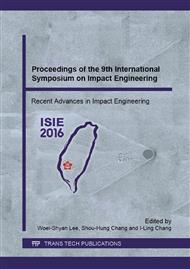p.68
p.74
p.80
p.86
p.95
p.101
p.107
p.111
p.116
Analysis of Plasma Created by High-Speed Impact with Triple Probe
Abstract:
The mechanism of destruction of a material by high-speed impact is known to be complex, and it is hard to analyze the inner state of the material during the destruction process. In particular, it is difficult to measure the temperature changes within a material during a high-speed impact. In this study, we propose a new method for estimating this temperature change by measuring the plasma produced at the impact point using a triple probe. A plasma produced by laser ablation was measured to ascertain that the triple probe actually worked. Further, some of the parameters related to the triple probe were varied, and the obtained results were compared, in order to determine the optimal parameters for measuring plasmas. A pulsed Nd-YAG laser with a fundamental wavelength of 1064 nm was employed to produce laser ablation. The laser was irradiated on a thin A2024 plate coated with a black paint. The expanding plasma plume was recorded with a high-speed camera, and the signal from the plasma was measured with the triple probe.
Info:
Periodical:
Pages:
95-100
Citation:
Online since:
September 2016
Authors:
Keywords:
Price:
Сopyright:
© 2016 Trans Tech Publications Ltd. All Rights Reserved
Share:
Citation:


